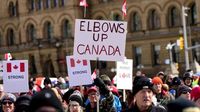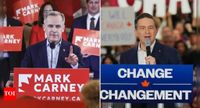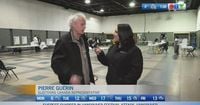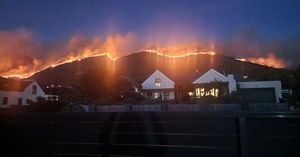As Canadians flocked to the polls for the federal election on April 28, 2025, students at Thomas Haney Secondary School in Maple Ridge participated in a student vote, engaging in a democratic exercise that, while not officially counted, provided valuable lessons in civic participation.
Inside the school library, students lined up to ensure they were on the voters' list, cast their ballots behind privacy screens, and placed their votes into a secure ballot box. The atmosphere buzzed with excitement and anticipation as students discussed the importance of voting. George Lindquist, a student at the school, expressed his enthusiasm, stating, "I would say it's worthwhile voting as a student; it's part of the learning process." His sentiments echoed a broader sentiment among his peers, who recognized the significance of their involvement.
Mohammed Tuma, another participating student, noted that politics was a frequent topic in his family, which fueled his interest in the electoral process. "Usually I'm pretty interested in elections," he said while marking his ballot. Cameron Rowley, reflecting on what he learned during the campaign, voiced his disapproval of remarks against so-called "woke" values, explaining, "To be woke is to be woken to a problem that existed."
Teacher-librarian Megan Fulgueras, who organized the event, emphasized its educational value, saying, "They like to have a say." The student vote is part of a larger initiative involving 7,000 schools across Canada, aiming to engage young people in the democratic process. Fulgueras hopes that the results will inform political parties about how they resonate with future voters. "I hope they look at what their future voters are thinking," she remarked.
As the polls closed at 7 p.m. on April 28, 2025, Canadians awaited the results of a closely contested election. Early indications showed a tight race between the Liberal Party, led by incumbent Prime Minister Mark Carney, and the Conservative Party, headed by Pierre Poilievre. With a record 7.3 million Canadians voting early, the anticipation surrounding the election was palpable.
Initial results revealed that the Liberals had secured 21 seats out of 170 reported, while the Conservatives had claimed 9. As the counting continued, Carney's Liberal Party was projected to lead with 72 seats, compared to Poilievre's Conservatives with 58. In the context of Canadian federal elections, where the House of Commons comprises 343 seats, a party requires 172 seats to achieve a majority government.
The early turnout marked a significant milestone in Canadian electoral history, reflecting a growing engagement among voters. Elections Canada reported that a total of 28.9 million Canadians were eligible to vote, underscoring the importance of participation in the democratic process.
However, the election was not without its complications. The official Elections Canada website experienced technical issues, causing some voters to face challenges in accessing real-time results. Despite this setback, the direct results page remained operational, allowing citizens to stay informed as the results poured in.
Amid the election buzz, former U.S. President Donald Trump re-emerged as a controversial figure in the campaign, stirring discussions on Canadian sovereignty and trade. Trump's recent announcement of a 25% tariff on Canadian-made cars and his suggestion that he may use "economic force" to make Canada the 51st state of the United States added an unexpected twist to the political landscape. In a social media post, Trump urged Canadians to elect a leader capable of enhancing their economy and military power, stating, "Good luck to the Great people of Canada. Elect the man who has the strength and wisdom to cut your taxes in half, increase your military power, for free, to the highest level in the World... if Canada becomes the cherished 51st state of the United States of America."
This statement sparked debates across Canada, with many citizens reflecting on the implications of such a proposition. The notion of Canadian identity and independence became a focal point of discussions, particularly among younger voters who are increasingly aware of global political dynamics.
As the election results unfolded, the Canadian public remained vigilant, eager to see how their votes would shape the future of the country. With the polls closing officially at 10 p.m. EDT, the nation held its breath, awaiting the final tally and the potential implications for governance in the coming years.
In summary, the 2025 Canadian federal election not only showcased the democratic engagement of citizens but also highlighted the importance of youth participation in shaping political discourse. As students at Thomas Haney Secondary School demonstrated, even young voices can contribute to the evolving narrative of a nation, fostering conversations around critical issues and encouraging a new generation to take an active role in democracy.






